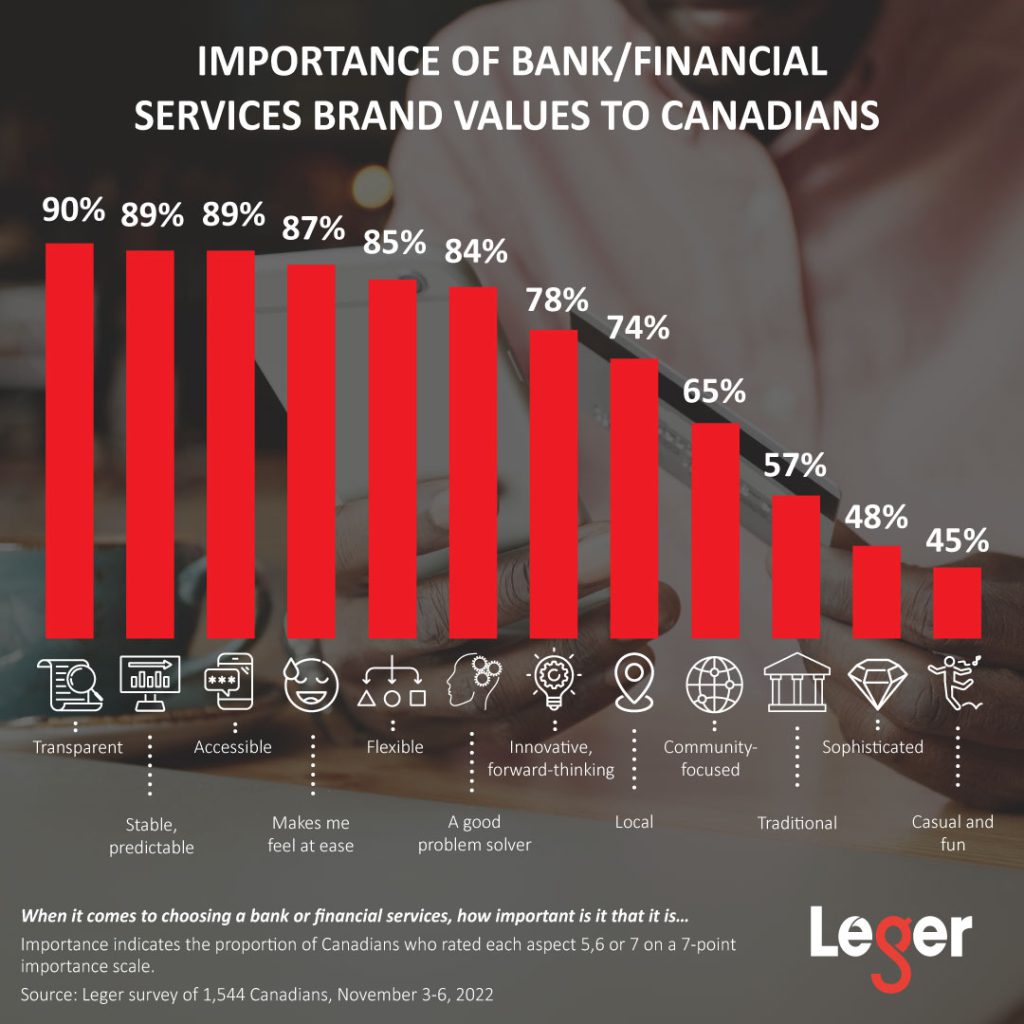This edition of Leger’s Tech and Innovation series explores Canadians’ perspectives on fintech in Canada, including online vs. traditional banking, NFTs, DeFi, cryptocurrency and more.
Leger’s Tech and Innovation series, launched in 2022, explores Canadians’ perceptions of technologies and innovations that are shaping our future. Led by Leger’s Alberta office, the series is designed to help governments and businesses understand public opinion, an important factor when designing new policies or preparing new product and service offerings. A new survey (accompanied by a free report) is released monthly.
FILL IN THE FORM BELOW TO DOWNLOAD THE FREE REPORT
ARE YOU INTERESTED IN LEARNING MORE? CLICK HERE TO CONTACT US.
OTHER ARTICLES IN THIS SERIES
Renewable Energy and Going Green
Tech Industry Talent, Attraction and Retention
Attitudes Toward Technology and the Metaverse
The last edition of the series will focus on education and be released in January. Stay tuned!
What is fintech in Canada all about? For those outside the fintech world, cryptocurrency, NFTs and DeFi may seem cryptic. But for those with intimate knowledge of the industry, the various technologies that fall under the fintech (or financial technology) umbrella offer the potential to revolutionize financial services as we know them.
According to Investopedia, “up until now, financial services institutions offered a variety of services under a single umbrella. The scope of these services encompassed a broad range from traditional banking activities to mortgage and trading services. In its most basic form, Fintech unbundles these services into individual offerings.”
What do Canadians think about fintech in Canada? Do they trust online banks? How much do they know about fintech? And how likely are they to use different financial technologies in the future? We conducted a large-scale online survey to find out.
SURVEY HIGHLIGHTS: FINTECH IN CANADA
WHILE TRADITIONAL BANKS STILL DOMINATE THE CANADIAN MARKET, TWO-IN-FIVE WOULD CONSIDER AN ONLINE BANK FOR THEIR NEXT PRODUCT.
Canadians who are likely to consider an online bank place the highest value on low account fees, the ability to manage everything online, and a user-friendly website/app.
Those likely to consider an online bank are more likely to be under 55, male, employed, have an annual income of over $60,000, and have a university education.
ONLINE BANKS WILL NEED TO DIFFERENTIATE BEYOND OFFERING NEW TECHNOLOGIES SINCE MOST TRUST TRADITIONAL BANKS TO DELIVER ON THESE.
A strong majority trust traditional banks to adopt the newest technologies (82%), and also want their bank to adopt the newest technologies (80%).
This suggests traditional banks will continue to pose tough competition to online banks, and that online banks will need to differentiate beyond their technology.
WHEN CHOOSING A BANK OR FINANCIAL SERVICES, CANADIANS ARE LOOKING FOR TRANSPARENCY, STABILITY/PREDICTABILITY AND ACCESSIBILITY.
These top brand values represent positioning and messaging opportunities for online banks, as they will resonate most with the Canadian market. The importance of other brand values to Canadians is shown below.

THERE IS AN OPPORTUNITY TO EDUCATE CANADIANS ABOUT FINTECH. WHILE MANY ARE AWARE OF THE TECHNOLOGIES THAT EXIST, FEW ARE KNOWLEDGEABLE.
Among those aware of each fintech trend/technology shown, more Canadians “don’t know very much” compared to those who know “a little” or “a lot” about each.
Financial technologies that Canadians are most knowledgeable about are cryptocurrencies, buy now/pay later (e.g., PayBright), and crowdfunding.
DESPITE NFTs BEING A HOT TOPIC IN THE MEDIA, THEY HAVE THE LOWEST USAGE INTENT VS. OTHER FINTECH TRENDS SHOWN.
Only one-quarter of those aware of NFTs are likely to use them. On the other hand, intent to use is highest for DeFi (decentralized finance) (49%), international online money transfers (48%) and peer-to-peer lending (44%).
Buy now, pay later (e.g., PayBright) has high awareness (62%) and intent to use (39%), suggesting it may be a trend that grows in future years.
SURVEY METHODOLOGY
- A total of 1,544 Canadians were surveyed from November 3 to 6, 2022. The respondents were randomly selected from Leger’s LEO panel.
- To ensure the sample is representative of the entire adult population of Canada, the raw data was weighted according to the actual distribution of the population based on gender, age and region using data from Statistics Canada’s latest available census.
- As a comparison, a probability sample of this size would have a margin of error of ±2.5% with a confidence interval of 95% (19 times out of 20).
